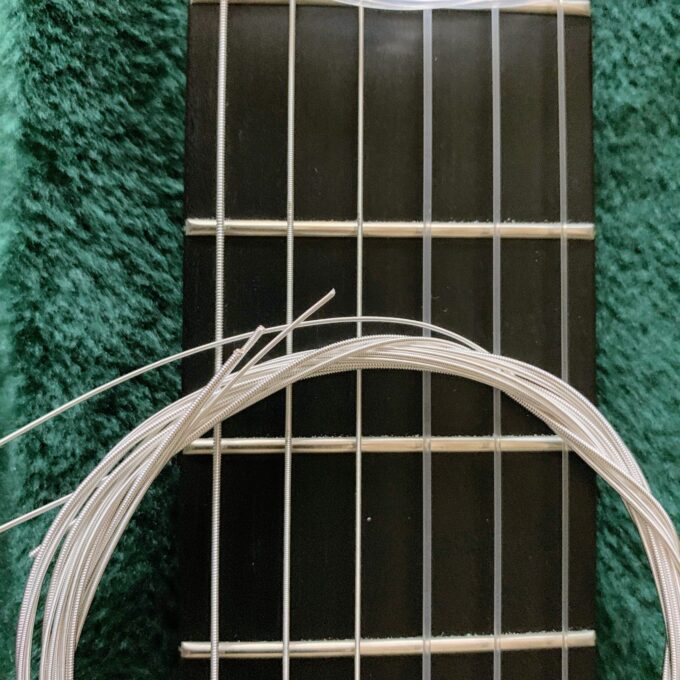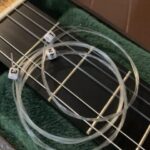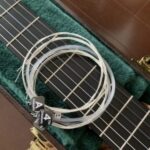This post is also available in:
![]() 日本語 (Japanese)
日本語 (Japanese)
I have introduced many strings in this blog, and I would like to summarize the recommended strings for different purposes and uses among them.

The following article summarizes the string reviews/impressions/information articles in this blog

- Basic Pro Arte.
- If you want cheap strings, try Hanabach 500.
- If you want to experience the latest trends in sound, try Sabares Cantiga/Cantiga Premium.
- If you want a sweet, lustrous sound, go with Augustine.
- If you want a solid, thick sound, go with Hanabach.
- If you want a sound that flies sharp and far, Dougal Diamante.
- If you have tendinitis and want a string with less tension, use Dougal’s Diamante or Aquila’s Zaffiro.
- Dougal Diamante or Savares Cantiga Premium if you prefer a string with a longer sustain
- Aquila Perla if you want a short sustained sound.
- Looks matter! Then Aquila Sugar and Dougal Maestrale.
- For people who just want cheap strings.
- I want to make the same sound as the guitarist I admire.
- My personal favorites
- Try different strings to find the sound you want to make.
Basic Pro Arte.
I think the basic one is still Pro Arte.
The power structure of classical guitar strings is also changing, so it may no longer be the case that pro-arte is considered basic.
However, I still think that this is the basis for Pro Arte’s habit-free sound quality.
There are various series of Pro Arte, but the traditional EJ-45 is recommended as the basic model.
When you try so many strings, it can be hard to know what’s right for you. When that happens, go back to Pro Arte.
If you want cheap strings, try Hanabach 500.
If you prefer cheap strings but want to use strings made by a reputable manufacturer, I recommend Hannabach’s 500 series.
These strings are made for students learning guitar, and can be purchased for around 700 yen per set, depending on the store.
Of course, I heard that they keep the quality of Hanabach, so you could use this for practice and a different series of Hanabach for the performance.
If you want to experience the latest trends in sound, try Sabares Cantiga/Cantiga Premium.
Personally, I think the most popular string right now is the Sabares Cantiga/Cantiga Premium.
The clear high strings and supple bass are attractive, and many professional guitarists seem to use them.
Many cantigas have been introduced in this blog:

If you want a sweet, lustrous sound, go with Augustine.
If you want a sweet and lustrous sound that is typical of Spanish classical guitars, the Augustin is the way to go.
However, there are many different types of Augustin strings, and if you want a sweet and lustrous sound, I think Regal or Blue/Red/Black are good for high notes. If you want a sweet and shiny sound, Regal or Blue/Red/Black are good for high notes. Imperials are also good, but they produce a relatively clear sound among Augustin strings.
By the way, the blue/red/black treble strings seem to be the same.
Recently, a carbon string called Paragon has been introduced.
I haven’t tried it yet, but I’m wondering if the sound is in the direction that is typical of Augustine, or if it’s the clear and loud one that is so popular these days.
If you want a solid, thick sound, go with Hanabach.
If you want a sound with a solid core, Hanabach is the way to go.
Compared to other strings, I feel that the fundamental component is stronger than the overtone component, which makes the sound more solid and thick.
Hanabach has a variety of series, but I think it would be a good idea to try the 815 Silver Special first.
If you want a sound that flies sharp and far, Dougal Diamante.
If you want a sharp, far-flying sound rather than a heavy one, I recommend Dougal’s Diamante.

New materials are used for both the treble and bass strings, and the sound travels far with a light touch.
If you have tendinitis and want a string with less tension, use Dougal’s Diamante or Aquila’s Zaffiro.
High tension strings are hard on the fingers when they are injured by tendinitis or other problems. Also, instruments that have been made for a long time are said to be better with low tension strings.
The one with the lowest tension of all the different ones I tried was the Dougal Diamante Extra Soft.
It’s not squishy by any means, but it’s soft enough that you can feel your fingers pressing the strings against the frets when you play seh with your left hand.
Diamante’s Extra Soft is hard to find in Japan, so I also recommend Aquila’s Zaffiro: it’s the best of both worlds.
It uses an unusual high-pitched string that is made from 100% plant-derived raw materials.
Dougal Diamante or Savares Cantiga Premium if you prefer a string with a longer sustain
If you want a sound that lasts a long time after the string is plucked, I recommend Dougal’s Diamante. It has a long sustained sound in both high and low notes. If you are more interested in sustain than weight, this is a good choice.
The Sabares Cantiga Premium also has a long sustain on the bass strings.
The combination of Ariance on the treble strings has a much longer sustain on both bass and treble.
Aquila Perla if you want a short sustained sound.
On the other hand, if you prefer a sound with short sustain, I recommend Aquila’s Perla.
It produces a sound with the feeling of vibrating wood. It’s not quite like an ancient instrument, but it’s interesting to hear a different direction from what is popular these days.
Looks matter! Then Aquila Sugar and Dougal Maestrale.
I want my strings to look like no one else’s! If that’s the case, we have the perfect thing for you.
First, the bass string is Aquila’s Sugar.
The bass strings have a red metallic coating, and it looks very much like a classical guitar.
The treble strings feature Dougal’s Maestrale.
What a blue and thick string. This is also quite impressive in appearance.
For people who just want cheap strings.
Changing classical guitar strings can be expensive, so some people prefer to buy cheap strings. Here is a list of inexpensive strings for those people.
I want to make the same sound as the guitarist I admire.
If there is a guitarist whose sound you like, you can try to use that reduction.
However, the question is whether the strings alone can produce that sound.
My personal favorites
Finally, my personal favorites…. I’ll probably update this as things may change.
I like the Sabares Creation Cantiga Premium because of its powerful and gorgeous sound. The bass strings last a long time, and I think you can’t go wrong with these strings.
However, Creation Cantiga Premium is too glamorous and can be tiring sometimes. In such cases, I also recommend Dougal’s Diamante.
Basically, it has a gentle and soft sound, but it can also produce other sounds depending on how it hits the nail and where it is played. It is also characterized by its low tension, which makes it easy to play and puts less stress on the fingers.
I’ve also recently tried the Labella 2001, and it’s skyrocketing. It has no weaknesses and is easy to play, so it is fun to play.
At the moment, I feel that these three are the three aces. I’m wavering between the gorgeous Sabares, the low tension and easy to play Dougal, and the flawless and fun to play Lavela.
Try different strings to find the sound you want to make.
Classical guitar strings are cheaper than violin strings, and can be changed with relative ease.
However, there is a big change in sound when you change the strings, and you may be surprised to find out that this instrument can produce such a sound (in both good and bad ways).
When you are practicing guitar, you may not know what sounds good or what kind of sound you want to produce, but in such cases, it is recommended to try different strings.
As you can experience the various sounds and their changes, you will begin to understand the direction of the sound you are looking for.
If you have only used one string, I encourage you to take a new step forward.


















